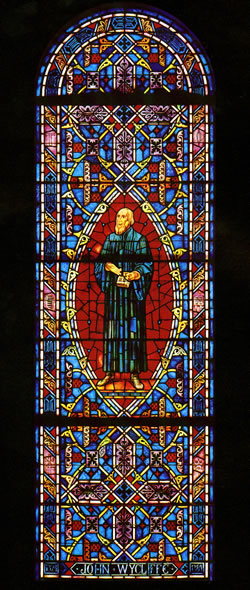
Wycliffe’s greatest influence on the Reformation came as a result of his Trialogus, a work on philosophy, and his English translation of the Latin Vulgate. This translation of the Bible was accomplished with the help of his friends, Nicholas of Hereford and John Purvey. A special order of “simple priests” preached his doctrines throughout the country and secured a great deal of popular support for him. John Huss was greatly influenced by Wycliffe’s work and later raised his doctrine to the dignity of a national religion.
The left side border symbols of the Wycliffe window, numbered top to bottom, are: 1. a tau cross made like the letter tau of the Greek alphabet, representing the shape of the pole upon which Moses lifted up the serpent (Numbers 21:8, 9; John 3:14); 2. a scroll representing membership in Christ’s church and symbolizing the hope that one’s name will appear in the “Lamb’s Book of Life” (Revelation 21:27); and 3. the shield of Peter symbolizing the tradition that said Peter was crucified upside-down because of his confessed unworthiness to be crucified like his Lord.
The right side border symbols of the Wycliffe window, numbered top to bottom, are: 1. a vesica symbolizing vesica piscis (bladder of the fish). the significance of the fish and the vesica symbols is the same, “Jesus Christ, Son of God, Savior” (cf. Martin Luther Window, border left 3.); 2. a Bible with the letters “VDMA” across it representing the Latin phrase Verbum Dei-Manet (in) Aeternum (The Word of God Remains [or Abides] Forever); and 3. the Star of Epiphany representing the manifestation of Jesus to the Gentiles and teaching the lesson of the universality of the Gospel.














